Time moves crankily during this pandemic. September is nearly over, and I’ve just watched on my laptop a video of a performance by Elizabeth Streb’s “live action heroes” that took place at Jacob’s Pillow more than a week ago. I’ve had to compare my notes with another slightly conflicting program list.
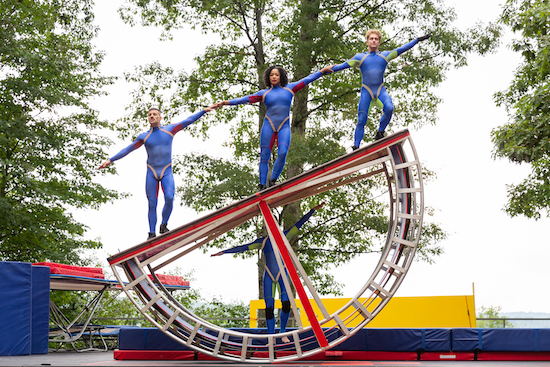
I thought writing about this retrospective, “Streb: From Ringside to Extreme Action,” would be timely. In this pandemic we need heroes. Her eight dancers are adroit, beautiful. Their toes point, their legs stretch, their bodies arch. But they don’t spend time being lyrical. I think back to Filippo Taglioni preparing his daughter Marie to debut in his 1832 La Sylphide. In order for her to waft about on the tips of her toes looking insubstantial, he put her through two two-hour ballet classes every day until he deemed her tough enough totake on the role. She fainted often. Streb’s dancers are strong, and her choreography foregrounds that.
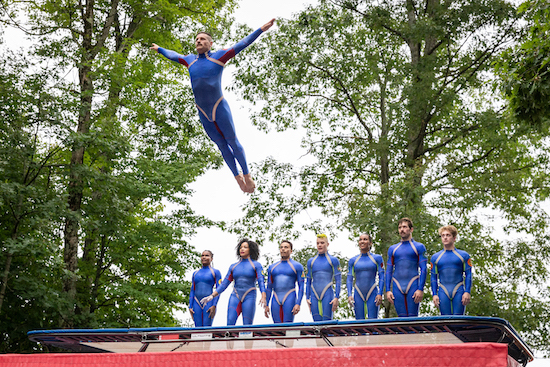
If you’re a Streb dancer, timing is crucial. You don’t want to fly off a piece of equipment and land on a fellow performer. Or have someone knock you out of place. Against the green trees that rise behind the Henry J. Leir outdoor stage at Jacob’s Pillow, the performers in their identical sky-blue unitards by Andrea Lauer call out warnings to each other and announce their intentions tersely and loudly, backed up by technical director/emcee/dj Zaire Baptiste. We spectators are advised to take out our phones and, perhaps, capture crucial moments.
The show offers a retrospective look at pieces Streb made before her equipment became immense and complex. Several date from the 1980s and 1970s. The most recent were made in 2002. We hear her voice commenting on their history, while the dancers and a costumed crew place, tape together, disconnect, and reposition the four big red padded platforms onto which the performers fall and from which they rebound. But their equipment includes more structures and objects, such as a trampoline and a twelve-foot long pole.
In the 2006 Tip that opens the show, a half circle twelve feet in diameter, set on its rounded edge, rocks from side to side, controlled in part by a dancer inside it. The six others run up and down its flat side, lie prone and cling to it like limpets to a rock as it becomes nearly vertical. One by one, they swan-dive off onto the red cushioning
.Watching the twelve short dances, you notice that everything that happens takes the time it takes. And sometimes that’s a split second. The equipment begins to seem like a live thing. In the 1978 Pole Vaults, Jackie Carlson mates with a long stick—holding it, spinning with it, cradling it, jumping over it, tossing and catching it, balancing it on her forehead. All this to an original music compilation produced by Voodoo Fé.
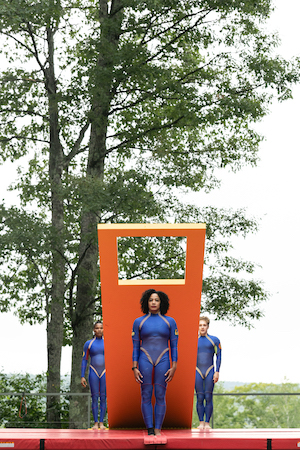
Cassandre Joseph doesn’t even blink when Buster‘s tall, narrow red and yellow flat falls over her from behind, its small window taking it just past her and to the floor. Two performers kneel facing each other some distance apart. Their bent-over backs support a pole across which others can walk. In Whiplash, Daniel Rysak does everything possible with a rope—jumping over it, spinning with it, throwing it up and capturing it again.
In the 1985 Little Ease, which I remember seeing Streb perform back then, Kairis Daniels lies in a not very large box, set horizontally atop another one. Within this box, she keeps rearranging herself, thumping against its surfaces, bracing herself askew. She can walk on her head and jump while supine. Audience members cheer and clap. Just watching her can induce claustrophobia.
You’re constantly aware of the importance of timing. How to keep a twelve-foot-long pole horizontal while others are riding it and ducking under it. How can the above-mentioned pair crouch down under its ends and support it on their backs for a comrade’s tightrope act? How in Target can a chartreuse hoop spin, walk beside you, and let you wear it as if it were a very big necklace? (This hoop decided to run away, but an audience member caught it and handed it back into captivity).
Panels become ramps. Become objects to fall on, to fall from, to fall with. I hear Streb’s voice mentioning “an irascible place to be.” Oh yes. As the dancers strip away the red tape that has linked the blue cushioned blocks together and reposition them, the trampoline manifests itself. (The audience applauds this setting up.) Good thing there isn’t a low ceiling for Air. Because the performers are vaulting off the high structure in dives and split leaps, and triple somersaults, alone and together, yelling as they go, as if to make sure they keep track of one another. Maybe landing on their bellies. And, briefly, alone against the sky.
Here are the names of those not mentioned yet. Tyler DuBoys, Justin Ross, Luciany Germán, Leonardo Girón Torres. All eight performers show us how to survive. And dare us not to.

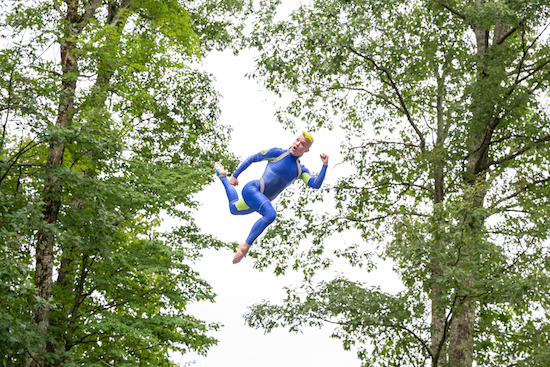
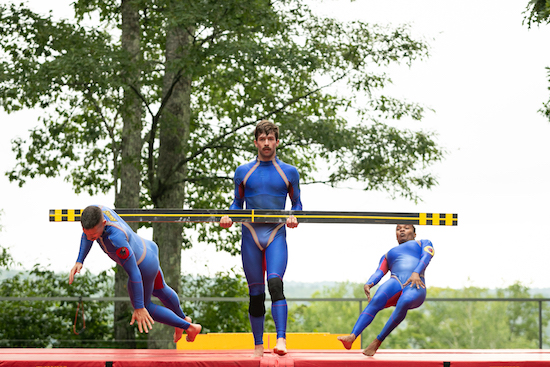
How wonderful to know that you were “with” us, Deborah – even if after the fact and online only! It’s a testament to all that’s made possible by technology, while Streb’s performers remind us what the human body can do. Thanks for your ever-astute observations.
After watching the documentary about Streb and her company, Born to Fly, I couldn’t watch any more performances. There is a cruelty in her belief system that–for me at least–cancels out the idea that dance is an art form and the performers are artists who must protect themselves while they protect and amplify the work. Yes, all the pyrotechnics are thrilling, And the audience gasps are always real (in person… I think on YouTube playback less so), but I don’t enjoy the thought of these dedicated bodies mashing themselves against gravity. I’m going to skip this one online.
The usual high wire feat of writing from a deeply rooted empathetic point of view.
I greatly appreciate these comments, They keep the work percolating in my mind and, I hope, in the minds of readers. Thank you!
Thank you for bringing to mind all the inventive constructs carefully forged in Streb’s work. Geometric constructs re-set for contact explorations. Streb, rough and real, delves into perfectionism with finely polished performers, a contrast of persona and product. The box piece still elicits a visceral seed in my body, real and rough like Streb herself as I remember her. And then there is her humor.
What a pleasure it is to read your thoughts, thank you.